Xueyuan Lin
LongFaith: Enhancing Long-Context Reasoning in LLMs with Faithful Synthetic Data
Feb 18, 2025Abstract:Despite the growing development of long-context large language models (LLMs), data-centric approaches relying on synthetic data have been hindered by issues related to faithfulness, which limit their effectiveness in enhancing model performance on tasks such as long-context reasoning and question answering (QA). These challenges are often exacerbated by misinformation caused by lack of verification, reasoning without attribution, and potential knowledge conflicts. We propose LongFaith, a novel pipeline for synthesizing faithful long-context reasoning instruction datasets. By integrating ground truth and citation-based reasoning prompts, we eliminate distractions and improve the accuracy of reasoning chains, thus mitigating the need for costly verification processes. We open-source two synthesized datasets, LongFaith-SFT and LongFaith-PO, which systematically address multiple dimensions of faithfulness, including verified reasoning, attribution, and contextual grounding. Extensive experiments on multi-hop reasoning datasets and LongBench demonstrate that models fine-tuned on these datasets significantly improve performance. Our ablation studies highlight the scalability and adaptability of the LongFaith pipeline, showcasing its broad applicability in developing long-context LLMs.
NQE: N-ary Query Embedding for Complex Query Answering over Hyper-relational Knowledge Graphs
Nov 24, 2022Abstract:Complex query answering (CQA) is an essential task for multi-hop and logical reasoning on knowledge graphs (KGs). Currently, most approaches are limited to queries among binary relational facts and pay less attention to n-ary facts (n>=2) containing more than two entities, which are more prevalent in the real world. Moreover, previous CQA methods can only make predictions for a few given types of queries and cannot be flexibly extended to more complex logical queries, which significantly limits their applications. To overcome these challenges, in this work, we propose a novel N-ary Query Embedding (NQE) model for CQA over hyper-relational knowledge graphs (HKGs), which include massive n-ary facts. The NQE utilizes a dual-heterogeneous Transformer encoder and fuzzy logic theory to satisfy all n-ary FOL queries, including existential quantifiers, conjunction, disjunction, and negation. We also propose a parallel processing algorithm that can train or predict arbitrary n-ary FOL queries in a single batch, regardless of the kind of each query, with good flexibility and extensibility. In addition, we generate a new CQA dataset WD50K-NFOL, including diverse n-ary FOL queries over WD50K. Experimental results on WD50K-NFOL and other standard CQA datasets show that NQE is the state-of-the-art CQA method over HKGs with good generalization capability. Our code and dataset are publicly available.
DHGE: Dual-view Hyper-Relational Knowledge Graph Embedding for Link Prediction and Entity Typing
Jul 18, 2022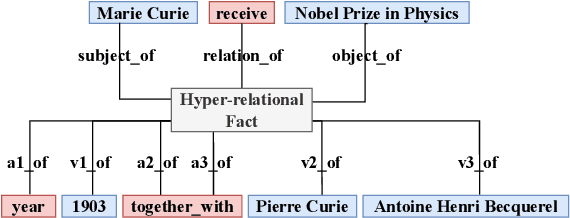
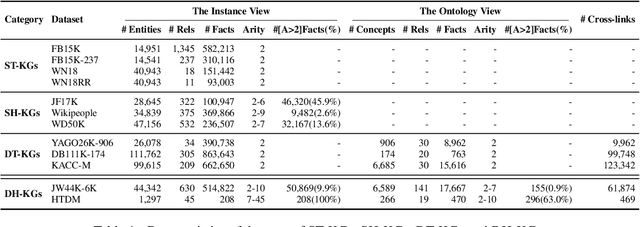
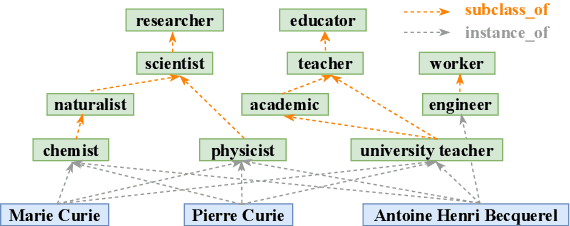
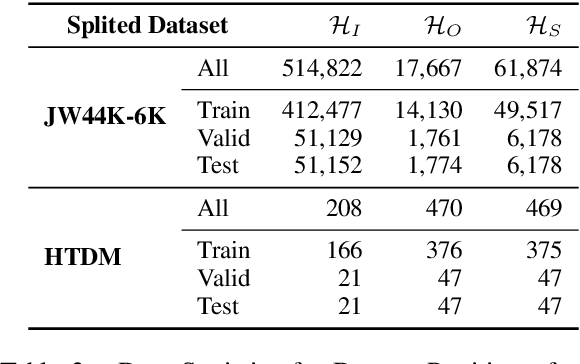
Abstract:In the field of representation learning on knowledge graphs (KGs), a hyper-relational fact consists of a main triple and several auxiliary attribute value descriptions, which is considered to be more comprehensive and specific than a triple-based fact. However, the existing hyper-relational KG embedding methods in a single view are limited in application due to weakening the hierarchical structure representing the affiliation between entities. To break this limitation, we propose a dual-view hyper-relational KG (DH-KG) structure which contains a hyper-relational instance view for entities and a hyper-relational ontology view for concepts abstracted hierarchically from entities to jointly model hyper-relational and hierarchical information. In this paper, we first define link prediction and entity typing tasks on DH-KG and construct two DH-KG datasets, JW44K-6K extracted from Wikidata and HTDM based on medical data. Furthermore, We propose a DH-KG embedding model DHGE, based on GRAN encoder, HGNN, and joint learning. Experimental results show that DHGE outperforms baseline models on DH-KG. We also provide an example of the application of this technology in the field of hypertension medication. Our model and datasets are publicly available.
TFLEX: Temporal Feature-Logic Embedding Framework for Complex Reasoning over Temporal Knowledge Graph
May 28, 2022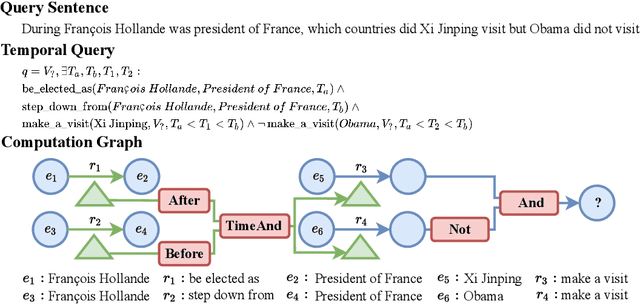


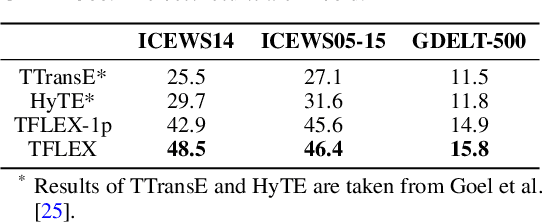
Abstract:Multi-hop logical reasoning over knowledge graph (KG) plays a fundamental role in many artificial intelligence tasks. Recent complex query embedding (CQE) methods for reasoning focus on static KGs, while temporal knowledge graphs (TKGs) have not been fully explored. Reasoning over TKGs has two challenges: 1. The query should answer entities or timestamps; 2. The operators should consider both set logic on entity set and temporal logic on timestamp set. To bridge this gap, we define the multi-hop logical reasoning problem on TKGs. With generated three datasets, we propose the first temporal CQE named Temporal Feature-Logic Embedding framework (TFLEX) to answer the temporal complex queries. We utilize vector logic to compute the logic part of Temporal Feature-Logic embeddings, thus naturally modeling all First-Order Logic (FOL) operations on entity set. In addition, our framework extends vector logic on timestamp set to cope with three extra temporal operators (After, Before and Between). Experiments on numerous query patterns demonstrate the effectiveness of our method.
FLEX: Feature-Logic Embedding Framework for CompleX Knowledge Graph Reasoning
May 23, 2022


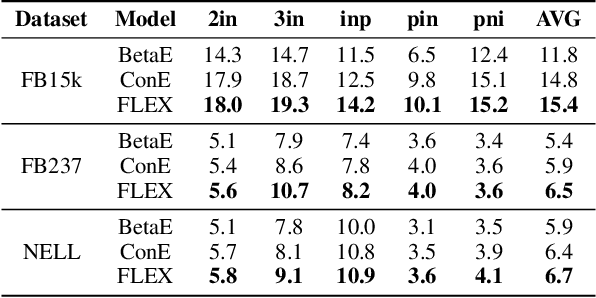
Abstract:Current best performing models for knowledge graph reasoning (KGR) are based on complex distribution or geometry objects to embed entities and first-order logical (FOL) queries in low-dimensional spaces. They can be summarized as a center-size framework (point/box/cone, Beta/Gaussian distribution, etc.) whose logical reasoning ability is limited by the expressiveness of the relevant mathematical concepts. Because too deeply the center and the size depend on each other, it is difficult to integrate the logical reasoning ability with other models. To address these challenges, we instead propose a novel KGR framework named Feature-Logic Embedding framework, FLEX, which is the first KGR framework that can not only TRULY handle all FOL operations including conjunction, disjunction, negation and so on, but also support various feature spaces. Specifically, the logic part of feature-logic framework is based on vector logic, which naturally models all FOL operations. Experiments demonstrate that FLEX significantly outperforms existing state-of-the-art methods on benchmark datasets.
EchoEA: Echo Information between Entities and Relations for Entity Alignment
Jul 07, 2021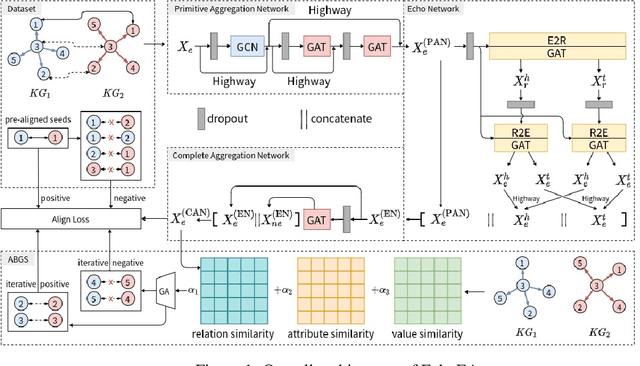

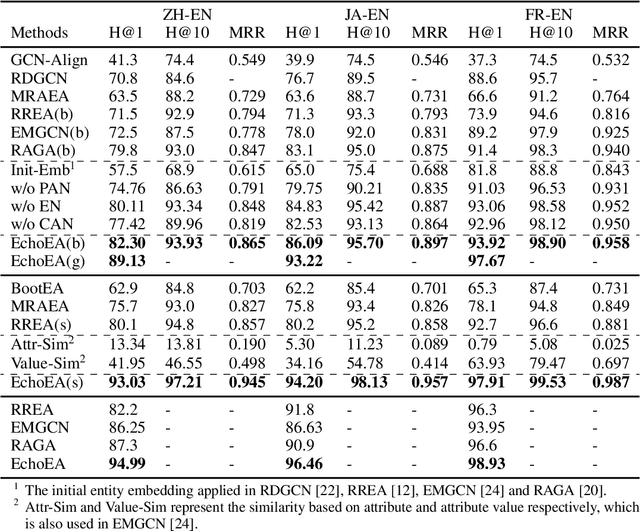
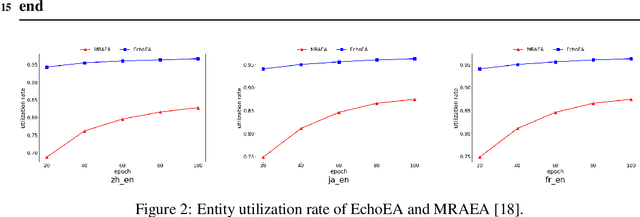
Abstract:Entity alignment (EA) is to discover entities referring to the same object in the real world from different knowledge graphs (KGs). It plays an important role in automatically integrating KGs from multiple sources. Existing knowledge graph embedding (KGE) methods based on Graph Neural Networks (GNNs) have achieved promising results, which enhance entity representation with relation information unidirectionally. Besides, more and more methods introduce semi-supervision to ask for more labeled training data. However, two challenges still exist in these methods: (1) Insufficient interaction: The interaction between entities and relations is insufficiently utilized. (2) Low-quality bootstrapping: The generated semi-supervised data is of low quality. In this paper, we propose a novel framework, Echo Entity Alignment (EchoEA), which leverages self-attention mechanism to spread entity information to relations and echo back to entities. The relation representation is dynamically computed from entity representation. Symmetrically, the next entity representation is dynamically calculated from relation representation, which shows sufficient interaction. Furthermore, we propose attribute-combined bi-directional global-filtered strategy (ABGS) to improve bootstrapping, reduce false samples and generate high-quality training data. The experimental results on three real-world cross-lingual datasets are stable at around 96\% at hits@1 on average, showing that our approach not only significantly outperforms the state-of-the-art methods, but also is universal and transferable for existing KGE methods.
 Add to Chrome
Add to Chrome Add to Firefox
Add to Firefox Add to Edge
Add to Edge